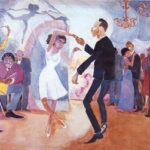The Mis-Education of the Negro stands as one of the most essential texts of the African American experience. Within its pages are the lessons of a people “mis-educated” to think they are inferior based solely on the color of their skin. The aftermath is one of confusion in which the African American unsuccessfully mimics the behavior of whites in his learned self-hate, leaving the gifts of his culture behind. Woodson takes an in-depth view to analyze racism in the educational system; he argues that mis-educated blacks are a hindrance rather than an aid in the progression of the race. He states, “The large majority of negroes who have put on the finishing touches of our best colleges are all but worthless in the development of their people.” (p. 2) In the end, he urges everyone (with no exception) to incorporate the history of African Americans into their curriculum and for African Americans to embrace the gifts of their own culture and trust them to bring progress to the race.
Woodson, the “Father of African American History”, published The Mis-Education of the Negro in 1933, about seventy-four years ago. In the year 2007, where are we now? Is The Mis-Education of the Negro an archetypal text of the past or does it still speak volumes of our present condition? This document will argue though we have come a long way since 1933, the residue of the African American’s “Mis-education” still lingers in our communities and the educational spectrum. Furthermore this residue will continue to oppress African Americans unless we acknowledge the problems and work to mend them. The Mis-Education of the Negro is just as relevant to the state of black America now, as it was then.
Early in The Mis-Education of the Negro, Woodson states:
“In the schools of Business administration, Negroes are trained exclusively in the psychology and Economics of Wall Street and are therefore, made to despise the opportunities… among their own people. Foreigners who have not studied economics but have studied Negroes take up this business and grow rich” (p. 5)
This principle is still true today considering the number of black owned businesses in relation to those owned by Whites, Asians, and Hispanics, in predominantly black neighborhoods. Dr. Victor Okafor, Professor of African American Studies asks:
How is it that predominantly African American neighborhoods in Philadelphia are served by businesses owned and operated mainly by Asian Americans or White Americans?
This situation is echoed all around the country. In a study, the Small Business Administration reported that in 2001, while there were 823,499 black owned small business firms, there were 912,959 Asian and Pacific Islander owned, and 1,199,896 Hispanic owned.
Another huge issue (both then and now) in predominantly black communities is the public education system. During the time of Woodson’s The Mis-Education of the Negro, African Americans were forced to be educated in segregated institutions at all levels. Decades after, the case ruling of 1954’s Brown vs. Board of Education integrated schools. Over 50 years later, the Black community faces inequality in education. In 2003 the National Center for Educational Statistics reported that African Americans score the worst of all races in both the SAT and the ACT. Furthermore 9% of the African American Population (the highest of all races) will graduate without ever once taking a mathematics course. Why does this continue? The same reason it existed in Woodson’s time. He states:
“Negroes have no control over their education and have little voice in their other affairs…. Negroes are always such a minority that they do not figure in the final working out of the educational program. The education of the Negroes, then, the most important thing in the uplift of the Negroes, is almost entirely in the hands of those who have enslaved them and now segregate them”. (p. 22)
We are aware that segregation in schools is illegal; however, we have subtle segregation in which African- Americans in predominantly black areas, going to their neighborhood schools, are at the bottom of the totem pole in quality of education. If a Black student residing in the “ghetto” and his white counterpart, in the suburbs, both go to their neighborhood (public) school, the white student would receive a much better education. In the end the majority of black students are still at a disadvantage.
Another constant issue of Education today is the outstanding numbers of African-American students in special education programs. According to the National Alliance of Black School Educators:
In many cases, children are inappropriately referred and erroneously determined to require special education and related services when, in fact, they do not. When this happens repeatedly and primarily to one group of students in a school district-as is the case for African American students in many districts across the country-it results in a disproportionate percentage of group membership in special education.
Instances like these push the mis-education of African Americans forward. If most of African American students are told that they can’t learn at a normal level when in all actuality they can, it will breed self- hate. What difference would this be from the struggles of Woodson’s era for these students? This situation is basically teaching African American children that they are inferior but in subtleties compared to the blatancy of the 1930’s and earlier. Our Present condition reminds me when Woodson states: “Even schools for Negroes, then are places where they must be convinced of their inferiority (p. 2).
Woodson spoke in great detail of the state of the African American church. He criticizes the church for focusing more on fire and brimstone than uplifting the people. He also considers the way blacks conduct church services as an act of ignorance. I found it very interesting that the Author would criticize black churches for taking a religion and making it their own, using traditions that go way back to Africa, all the trying to convince blacks that they should embrace the gifts of their culture. I disagree with his statements on the Black church, and I believe our modern day black churches are successful in embracing black culture and may be one of our strongest forces in the Black community. This text was published before the civil rights movement, lead by Ministers and Preachers of the black church! The church pew was the seat of revolution for blacks during that time. Woodson argues that we do away with the religion blacks were taught from their slaveholders. I believe in our present situation, we’ve made great strides in the church; there we can find the unity, strength and power of the African-American race.
So, is Black America still mis-educated? I say yes! This mis-education is apparent in our communities, our school systems and our daily lives. We do however have the resources available to re-educate ourselves. In the year 2007, we have more power now than ever before. We can break down this system of mis-education and start anew. The change lies in acknowledging the mis-education, as Woodson has shown us, and modifying our thinking and actions.
“Addressing Over-representation of African Americans in Special Education.” (2002): National Alliance of Black School Educators, (Feb. 17, 2007).
National Council for Educational Statistics. NSES 2005 Programs and Plans: Chapter 5 Educational assessment, 2005. n.d.
Okafor, Victor. “A Reevaluation of African Education: Woodson Revisited.” Journal of Black Studies 22, no. 4 (1992): 579-592.
Small Business Administration. Minorities in Business 2001, 2001. n.d.
Woodson, Carter G. The Mis-Education of the Negro. Washington D.C.: Associated Publishers, 1933.




